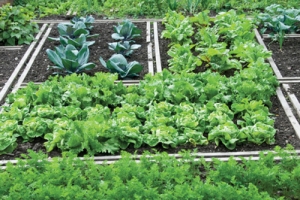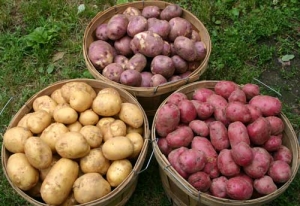Fall Vegetable Gardening Starts Now
By Marsha Goldberg, Fairfax Master Gardener
You’re finally enjoying the luscious bounty from your garden, the payoff for all the hard work you did this spring by starting seeds or moving transplants to your plot. You can pick most of those wonderful summer vegetables and use the pungent herbs right up until the first frost kills them. In Fairfax County the first frost hits somewhere between October 19th and October 29th to the west of I-95 and early November to the east and south, according to the Virginia Cooperative Extension (VCE).

Being a cool season crop, lettuce is perfect for a fall garden
If you harvested early season vegetables such as lettuce, peas, and spinach in May, you can use their planting spots for fall crops. Amend the soil with fresh compost and let it rest for a few weeks before planting new seeds in late summer. Most seeds will germinate in the heat and then start producing as the weather turns cool. Some lettuce varieties, however, do not germinate well in soil temperatures above 75 degrees F. Read the instructions on the seed packet. You may have to wait until the soil temperature in your garden drops below 70 degrees F or start the seeds in trays indoors.
The trick for cool season vegetables is timing. If you plant the seeds too early, they germinate and grow quickly while it is still hot. They may not do well. Moreover, if they mature in hot weather, they may acquire a bitter taste. If you plant them too late, they may not have established themselves enough to survive the frost. The VCE has great information and a handy chart that will help you count back from the typical first frost date for our area and show the dates when you should plant cool weather crops.

Potatoes make a great fall crop going into winter
The amount you are able to harvest will depend on a number of factors such as the weather and the cultivar, or type of each vegetable, you put in. For example, some lettuce cultivars are bred to keep producing in winter. Even these, however, struggle in the bitter “polar vortex” winter weather we have experienced the past two years.
You can also extend the growing season by covering your vegetables with row covers or using a cold frame. It does not have to be a complicated process. If you want to learn more, or if you have questions, visit Virginia Cooperative Extension where a search will yield many articles about planting cool weather crops in our area. You can also stop by the Master Gardener plant clinic at your local farmers market and at selected libraries in Fairfax County. Master Gardeners are always happy to help!
Resources
Planting vegetables in midsummer for fall harvest, University of Minnesota Extension
Starting a Fall Vegetable Garden, Cornell University Cooperative Extension